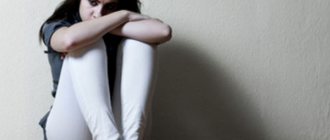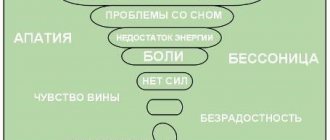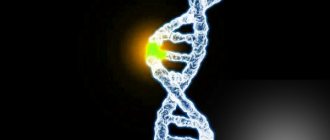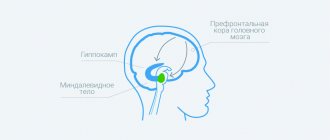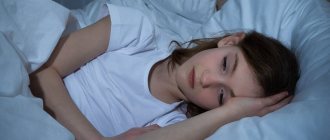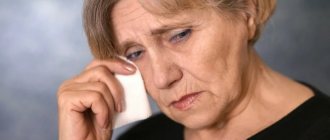What is recurrent depression?
Recurrent (lat. recurrens - “returning”) disorder is established when depressive episodes are repeated throughout the year with a certain frequency.
Each of them is associated with loss of interests, persistently depressed mood, and increased mental and physical fatigue. The ICD-10 code is F33. Between periods of exacerbation, a person feels absolutely normal (intermission). To make a diagnosis, symptoms must meet DSM-V and ICD-10 (International Classification of Diseases, 10th Revision) criteria. It is important that there is no history of hyperactivity or inappropriately elevated mood associated with mania. When they appear, the conclusion is changed to “bipolar affective disorder” (F31. -).
Reasons for development
It is still unknown what exactly leads to the formation of affective disorders (mood pathologies). The role of the following factors is suspected:
- genetically determined insufficiency of the activity of the main neurotransmitters of the central nervous system (norepinephrine, dopamine, serotonin, melatonin) - monoamine theory;
- psychosocial distress;
- reaction to a traumatic event (individual for a person);
- endocrine (hormonal) imbalance;
- the presence of somatic disability, for example, disability or severe chronic disease.
The occurrence of the first depressive episodes may be a response to external provocative events, usually psychological trauma. Repeated exacerbations usually have no connection with external conditions.
The majority of patients are women, but every year the number of men seeking help increases. Without treatment, 85% experience frequent relapses with a tendency to protracted course.
Symptoms
The recurrent nature of the disease is confirmed if the patient suffered at least 2 episodes (or one severe one), each of which lasted two weeks or more. In this case, a person must have intervals of normal life between exacerbations of at least two months.
A depressive episode has the following symptoms:
- The main ones: unexplained fatigue, a feeling of constant decrease in energy, the inability to experience positive emotions from previous activities (which previously brought joy), low mood.
- Additional: disturbances in appetite and sleep, a pessimistic view of the future, decreased self-esteem, uncertainty in all areas of life, deterioration in concentration, pathological ideas of guilt (self-deprecation).
- The symptoms are not caused by brain damage.
- Apart from depressive episodes, no hypomanic symptoms were noticed from the onset of the disease.
Clinical manifestations intensify closer to the morning. The resulting disturbances can affect libido, reduce mental and cognitive activity, and negatively affect performance. In severe cases, symptoms significantly impair social functioning; delusions, hallucinations, and stupor may occur.
After the end of the depressive episode, the patient returns to the previous level of life that was before the disease. In approximately 20-30% of cases, mild residual symptoms persist, which can be effectively relieved with therapy.
Features of the course
Periodic schizophrenia has a lot in common with affective psychoses. It occupies a borderline position in the classification of schizophrenia and affective disorders. The favorable course of the disease and the development of pronounced affective disorders at the time of the attack brings recurrent schizophrenia closer to manic-depressive psychoses, but the occurrence of catatonic and delusional disorders makes it possible to consider this pathology as a form of schizophrenia. In the specialized literature you can find the following names for recurrent schizophrenia: atypical variant of manic-depressive psychosis, schizoaffective psychosis. Quite often this pathology is called the third endogenous disease.
The recurrent form of schizophrenia is characterized by several types of attacks, each of which has psychopathological features. But they have one thing in common: affective disorders develop against the background of an attack. The patient may experience depressive, manic or mixed states. Sensual delirium can take various forms, up to oneiric stupor. Catatonic disorders may also occur.
Experts identify the following types of attacks of periodic schizophrenia:
- Manifest. This type of attack is typical for young people; their number may vary. In some patients, attacks occur regularly and quite often (approximately every 2–3 years), while in other patients, attacks occur several times throughout life (in old age and adolescence). The number of people who have suffered just one attack in their entire life is 30% of the total number of patients. Such attacks can occur spontaneously or as a result of exposure to a provoking factor (intoxication, various somatic diseases, childbirth in women, etc.). Shortly before the first manifest attack occurs, the patient experiences mild affective disorders. Such fluctuations usually do not affect a person’s performance and productivity. When the disease enters the initial period, the severity of affective fluctuations increases, against their background somatopsychiatric depersonalization may develop. The patient may experience bliss, be in a high mood, strive for vigorous activity, but after some time his condition changes dramatically. The period of emotional uplift is replaced by lethargy, a significant decrease in the level of activity, and inactivity. In this state, a person greatly exaggerates the significance of small conflicts that occur in reality. Sleep problems arise, manifested by painful insomnia or particularly vivid dreams. Very often, patients are visited by a premonition of some kind of incident; they feel as if they are going crazy.
- Oneiric-catatonic. This type of attack of periodic schizophrenia is characterized by the emergence of involuntary fantasies that arise at a certain stage in the development of the attack. The patient vividly imagines flights to distant planets, terrible wars, world catastrophes, travel, etc. A feature of periodic schizophrenia is that a person retains the ability to correctly navigate the environment and perceive the world around him. A state gradually develops in which the individual completely detaches himself from reality, plunging into fantastic experiences (oneiric clouding of consciousness).
- Depressive-paranoid. Such attacks are most often accompanied by increased anxiety; sensory delirium is based on the idea of condemnation or persecution. In the acute phase of a depressive-paranoid attack, oneiric episodes rarely occur. Attacks of this nature tend to last longer than others.
- An affective attack does not develop as harmoniously as other types of attacks characteristic of recurrent schizophrenia. The intensity of affect increases gradually; the attack is characterized by the presence of mixed states and the absence of the classical affective triad. The clinical picture of the disease often changes; during an attack, acute delusional ideas are replaced by oneiroid or catatonic symptoms.
Each of the described types of recurrent schizophrenia has its own psychopathic characteristics, but they all develop according to one general pattern. The first stage of an attack
with the development of affective circle disorders. When the attack enters the second stage, the patient experiences acute sensory delirium. The third stage is characterized by the presence of oneiric stupefaction. Whether an attack belongs to a particular type is determined by the dominant symptom of the disease. If oneiroids come to the fore, then the attack is called oneiroid-catatonic, the predominance of affective disorders suggests the development of an affective attack, etc.
An attack of recurrent schizophrenia can last for several months; there are cases where the attack lasted several years. Prolonged attacks are most often depressive.
Regardless of the duration of attacks and the frequency of their occurrence, with periodic schizophrenia, pronounced personality changes do not occur, as happens with other types of illness.
Features of the course of recurrent schizophrenia largely depend on the age of the patient. If the first attack of the disease occurs before the age of 25, then it will be characterized by the presence of oneiric-catatonic disorders. In the future, their intensity will be noticeably reduced.
Subsequent attacks may stop their development at the stage of staging, when the patient perceives the world around him as a theatrical action, or acute delirium. Attacks that occur later are manifested only by affective disorders.
If recurrent schizophrenia develops in a patient over 25 years of age, then oneiric-catatonic states usually do not develop. The attacks are affective in nature or accompanied by acute delirium.
Kinds
To determine treatment tactics, it is important to establish the severity of the developed disease. Episodes may also differ in the severity of symptoms. Transformation into other types of depressive disorders, for example, bipolar affective disorder (BAD), is not excluded.
Lightweight
To confirm a mild variant, the appearance of 2 main and additional symptoms of the episode is necessary. People with such recurrent depression are able to maintain social functioning. However, the quality of life still decreases. Somatic manifestations may be absent.
Moderate
With moderate recurrent depression, performing everyday tasks becomes almost impossible. A person cannot normally analyze information, study or work. Interpersonal relationships among family, friends, and loved ones suffer. For diagnosis, 2 main and 3-4 additional symptoms are enough.
Heavy
A severe depressive episode dramatically disrupts the social well-being of the patient. He loses the ability to perform not only work, but also household duties. There is a critical loss of interest in what is happening, nothing brings joy.
In this case, all the main symptoms, as well as 4 or more additional ones, are observed. Some episodes are aggravated by psychotic symptoms - delusions, hallucinosis, movement disorders or stupor. Increased risk of suicidal behavior.
Depressive disorders are the second leading medical cause of disability and mortality. WHO (World Health Organization) calls for combating the problem at the international level, having adopted a special resolution in 2013.
Recurrent depressive episode
A recurrent depressive episode is noted in the case of periodic repetition of affective attacks with symptoms typical for this deviation. They may be considered a mental illness in their own right, or they may manifest as clinical depression, bipolar disorder, or another personality disorder. Experts distinguish several types of recurrent depression:
- anxious;
- asthenic;
- apathetic;
- premenstrual;
- seasonal.
In the anxious form, the patient experiences simultaneous signs of anxiety and depressed mood. The pathology is often combined with panic attacks and phobias. The asthenic type of deviation manifests itself in the form of a strong loss of strength and a feeling of constant fatigue. In the apathetic variant, complete loss of interest in life and psychomotor retardation predominate.
Premenstrual depressive episodes occur in women with some regularity and are triggered by hormonal changes. It begins a week before the start of menstruation and lasts no more than 10 days. It is not characterized by a severe course. The seasonal type of deviation is usually observed in spring and autumn. Experts believe that the pathology is based on a lack of vitamin D in the body, without which normal production of serotonin is impossible.
Dr. Isaev’s clinic has all the conditions to provide effective assistance for depressive episodes of any severity. Dial our number and call a specialist at home or make an appointment.



